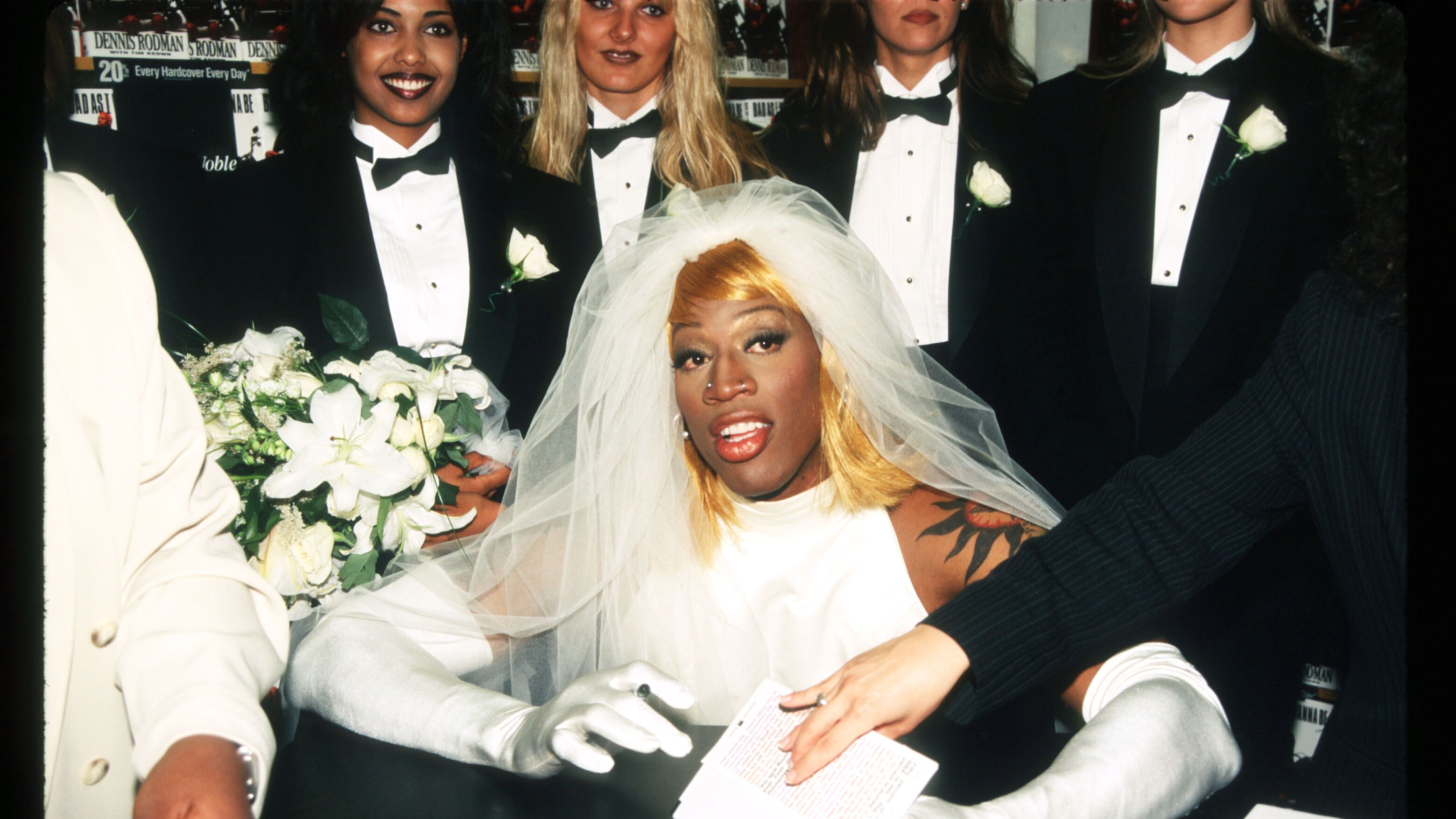Gender-Sexuality and Semiotics-Psychoanalysis
November 6, 2022
Gender-Sexuality Analysis- Dennis Rodman and Gender Non-Comformity
-

The 90's basketball scene was dominated by Michael Jordan and the Chicago Bulls, but besides the obvious attention a winning team would receive, eyes were also regularly on Bulls power forward Dennis Rodman. Rodman was commonly known for his eccentric style and open objection to typical gender rules. With a constant spotlight on the team, Rodman's style was always a conversation amongst the other basketball greats. He was obviously self aware and could see the turmoil and criticism that was caused with his personality, and enjoyed being the topic of conversation. His action were often viewed as self-centered or just to gain media attention, yet he was one of the only athletes at this time to truly live his personality and challenge gender rules of a hyper-masculine idea of the common male professional athlete.
Interviews were not uncommon for Rodman; one of the most memorable and eye-opening to the public was an interview he did on Oprah, where the unconscious gender biases and ideas of the age were put on display through Oprah's interview questions as well as the crowd's reaction. In the interview, Oprah questions Rodman rather bluntly, asking him in quick succession, "So... are you bisexual?"... "If you were gay, I believe you'd tell me." Rather than living with and trying to understand the answers Rodman gives, she continues to poke questions versus letting Rodman define his sexuality. He says that he is not gay, and not bisexual; after his answer, you can even hear a member of the audience clap as if to show he is happy he is not gay. The clip itself is glimpse into the mindset at the time; one where one will try and say they are accepting of a person for who they are, yet having unconscious thoughts that come out through the questions being asked, and the lack of a will to accept the real answers that are being given.
Rodman in other interviews reinstates the idea that he also can't say that he has not experimented with other men, "but I guess it depends on what you mean by experimenting." This combined with his other answers to Oprah's interview questions often confused the public. His answers were often on the minds of viewers, and he became an icon for gender non-conformity. One of the most memorable moments challenging the idea of a masculine athlete came after the publication of his autobiography. At a book signing event, Rodman wore a wedding dress to help his book gain attention and popularity. Though this was not the most eccentric display, he smashed the common conception of what a professional athlete had to be. Many people at the time did not understand his position and how he identified, and this event helped him solidify a meaning to his personality and sexual identity; it can be what you believe it is, and who you are shouldn't make a difference in the world no matter who you are. Rodman helped open the door to male expression in the sports world, and will certainly not be forgotten not just for his identity, but his immense skill on the court as well.
https://twitter.com/epithymia__/status/1254552630224814081?s=46&t=PpEUgMJbbgL5crFyh5f4aA
https://www.outsports.com/2020/5/5/21246976/dennis-rodman-sexuality-sports-the-last-dance-nba-bulls-documentary
Semiotic Analysis- Arrival by Denis Villeneuve
-

Arrival, directed by Denis Villeneuve, was released in 2016 but still to this day has viewers rethinking the way we see the world. Doing a semiotic analysis on this film is interesting, as the concept and premise of the movie looks at the way in which humans see language and communication. To summarize shortly, the film focuses on a linguistics professor named Louise Banks, who is hired by a team of investigators to help contact and create communication with extra terrestrial life forms. The movie itself reshapes the common idea of life-threatening aliens, as the spaceships that arrive on Earth never touch the planet to begin with, and there is no conflict or action-packed sequences of battles or firefights. Rather, instead of immediately firing on the spaceships, humans decide to try and make contact, which Louise tries to do with the help of her team. The aliens, later to be described as 'Hetapods', use various forms of circular symbols to communicate with the Louise and her team. By the end of the movie, they discover that the Heptapods don't view time linearly, rather as a ring or circle, able to perceive time in a way in which humans cannot truly comprehend. The aliens reveal that their true reason for coming to Earth was to pass on knowledge that was crucial for saving the planet from later destruction by humans.
The movie itself is interesting to analyze, as is the concept of linear progression of time, and how language truly shapes our reality. The means of communication that humans have used to interact has always been symbols and sounds. When used together, we are able to connect with each other on a very different level compared to other animals on our planet. In the film, when the spaceships touch down and the world comes to a standstill, viewers are left with the perplexing thought of if this could be accurate to what would happen in real life. How would humans react? Would there be chaos everywhere? Or would things begin to change and focuses, ideas, and mindsets begin to shift?
One thing to examine would be the syntagmatic and paradigmatic relationships within the film. Louise finds herself interacting regularly with the aliens, and over time as they begin to understand each other, she begins to understand that not only was she teaching the aliens language, but also the concept of language to begin with. The way language is used, in its different tenses and conjunctions, is different from what the extraterrestrials understand. An article from nofilmschool.com explains the idea of linguistic relativity, or the idea that our experiences are formed by cultural practices, including language, which shapes the way people think about the world. The article continues with the notion that language shapes perception by using a theory from Benjamin Whorf, a linguist of the 20th century, which compared the language of the Hopi and Inuit languages to the common English language, which found that the three languages have different understanding of numbers. This being how Hopi and Inuit use ordinal numbers, such as first, second, third, versus the English use cardinal, one, two, and three. The differences can be seen as almost a control over time, versus the other which does not consider time.
The overall effect the film had on viewers is a positive one, one that helps viewers view their world in a different way. The movie is a complex but interesting play on the way we perceive our reality when compared to the way in which other life forms might understand. It is also a helpful perception of how differently things might play out if humans are actually able to communicate and work towards a common goal in the time of a crisis. Communication and language help us molded by the world, as are our perceptions and how we see the world to begin with.
https://nofilmschool.com/ending-arrival-explained
Comments
Post a Comment